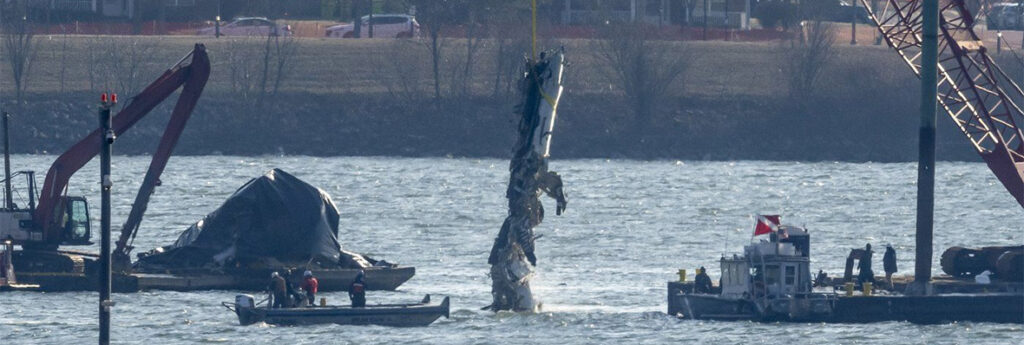Federal investigators looking into the cause of the January collision between a passenger jet and an Army helicopter near Washington, D.C., that killed 67 people recommended a ban on some helicopter flights Tuesday, saying the current setup “poses an intolerable risk.”
National Transportation Safety Board Chairwoman Jennifer Homendy laid out frightening statistics about near misses to underscore the danger that has existed for years near Ronald Reagan National Airport and expressed anger that it took a midair collision for it to come to light.
In just over three years, she said, there were 85 close calls when a few feet (meters) in the wrong direction could have resulted in the same kind of accident that happened Jan. 29 when the military helicopter collided with an American Airlines jet over the Potomac River as the plane was approaching the airport.
Transportation Secretary Sean Duffy said he’ll adopt the NTSB’s recommendations for the route where the midair collision occurred. He noted there will be some modifications in the guidelines to be released Wednesday, including allowing presidential flights and lifesaving missions.
Helicopters no longer will be “threading the needle” flying under landing planes, he said.
The Federal Aviation Administration also will use artificial intelligence to analyze data from every airport to make sure there aren’t similar dangers elsewhere, he said, adding that there are other airports with cross-traffic.
Homendy and Duffy both said the hazards at Reagan airport should have been recognized earlier by the FAA.
“The data was there. It wasn’t effectively analyzed to see we had this risk,” Duffy said.
Homendy said she was devastated for families that are grieving because they lost loved ones. Among the victims were 28 members of the figure skating community.
“It shouldn’t take tragedy to require immediate action,” she said.
Members of several families who lost loved ones said in a statement that the NTSB’s preliminary report showed this was not an isolated incident.
Aviation lawyer Robert Clifford, who represents at least six families, said the airline had a responsibility to address known problems.
“Those charged in transportation with the highest duty of care can’t run yellow lights, and they’ve been running flashing red lights for years, it sounds like, and it’s just pathetic,” he said.
Proposed changes aimed at improving safety
Under current practice helicopters and planes can be as close as 75 feet (23 meters) apart from each other during landing, Homendy said. Investigators have identified 15,000 instances of planes getting alerts about helicopters being in close proximity between October 2021 and December 2024, she said.
Investigators determined that planes got serious alerts to take evasive action because they were too close to a helicopter at least once a month between October 2011 and December 2024, Homendy said. In over half those instances, the helicopter may have been above its established altitude restriction for the route.
Safety advocate Mary Schiavo, a former Inspector General of the U.S. Transportation Department, called it a “shocking dereliction of duty” for the FAA to have failed to act on data the NTSB gathered in just a few weeks since the crash. She noted that the FAA had pledged to warn pilots about places with higher collision risk.
“They were going to really be proactive to warn pilots about these hotspots. I mean, this is beyond a hotspot,” Schiavo said. “This is absolutely radioactive, to have 15,214 close proximity events in three years, it’s unbelievable.”
Following the midair collision, the FAA took steps to restrict helicopter flights around the airport to ensure that planes and helicopters are no longer sharing the same airspace. Now flights are put on hold temporarily when helicopters need to pass by.
The NTSB’s proposal would close a vital route for law enforcement, Coast Guard patrols and government operations flights at times, but only when the runways in question are in use, and they account for only about 5% of flights at Reagan.
Homendy said the NTSB is recommending that the FAA find a “permanent solution” for alternate routes farther away for helicopter traffic.
A spate of recent aviation disasters
Within just a month’s time earlier this year, there were four major aviation disasters in North America, most recently in mid-February when a Delta flight flipped and landed on its roof at Toronto’s Pearson Airport, injuring 21 people.
Those accidents and close calls left some worried about the safety of flying, though fatal crashes are rare and US airlines’ track record is remarkably sound.
Federal officials have been raising concerns about an overtaxed and understaffed air traffic control system for years, especially after a series of close calls at airports.
Duffy said Tuesday that he will present an expensive plan to Congress within the next few weeks to overhaul the system with new technology. He hopes to complete it within four years.
If you enjoyed or found this story useful, we’d appreciate if you would forward it to a colleague or friend who may also enjoy it. If, on the other hand, a friend shared it with you, welcome! You can get all the latest travel news and reviews from Travel Industry by simply clicking HERE.

